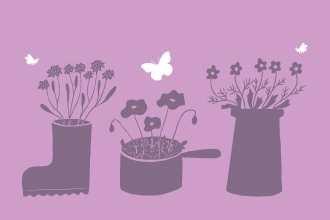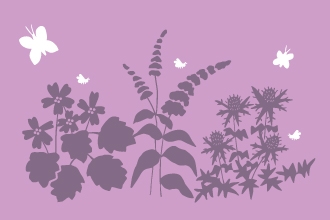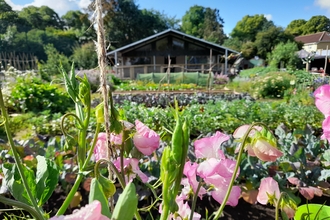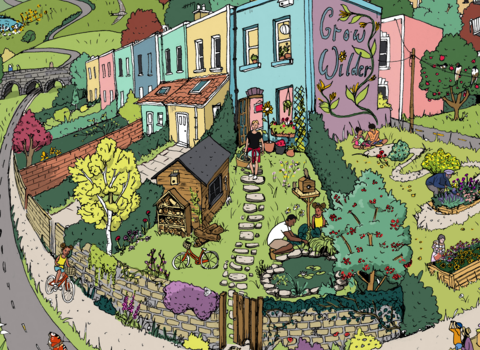
Hannah Bunn
Individual garden: Jenny Wellings
Name: Jenny Wellings
Category: Individual garden in the wildlife gardening competition 2023
Area: Brislington, Bristol, BS4
What makes your garden wildlife friendly?
Jenny: The pond and bog garden, the bird feeder and wild rough area underneath the weeping cherry tree where I throw dead plant material to encourage invertebrates and allow birds etc to rummage around there. I have hung up bug houses which appear to be almost full as most of the holes are currently plugged up. The wild flowers and pollinator plants, the different micro habitats and general relaxed gardening methods.
Tell us what you love about your garden
When I first bought my house the back garden was just hard landscaped with patio slabs. Over the years I had it replaced with lawn and then decking and also added a wildlife pond. There is a passageway at the back which leads down indirectly to some allotments and I added a hole for hedgehogs in the back gate. I did have hedgehogs visiting for a while but sadly none have been seen for three years now.
The decking was rotten, dangerous and had harboured rats underneath it so I had a new patio laid down and the grass lawn replaced with gravel last year. I decided to have wild flower lawn placed all around the pond and edges to compensate for the lack of grass and then added pollinating flowers in pots and baskets. The garden is a real haven.
It's small but bursting with life and sounds. The pond has frogs and currently tadpoles and damselflies, the lilies are just about to bloom. I feed the birds from a hanger on a weeping cherry tree and just love my visitors including the very rowdy starlings and their young. I have put up insect hotels and have placed ceramic Toad Abode houses in my darker side passage which is planted up with ferns.
Stephanie Chadwick
What wildlife have you seen in your garden?
Frogs, slow worms. Elephant tiger moth, hedgehogs, foxes, all manner of garden birds including black caps, jays and collard doves. And most astonishing of all a family of fox cubs! The garden shed is standing on concrete so the vixen didn't give birth to them under the shed but must have moved them there later. The cubs spent about three weeks sleeping there and coming out to explore my garden. They used my raised flowerbed as a play run and trashed the sweet peas initially, but I put choir matting around base of them as a distraction (which the blackbirds were seen taking for nesting material) and I'm happy to say they survived and are just coming into flower now. I'm sending in the video I took of the fox cubs playing in my patio rose tub which was taken in early May. The plants look quite small then but now all the flowers are out and things are brimming over, so I would like to send a photo of the garden as well.
Jenny won!
I do not use any pesticides and make my own. Leaving wild areas and not suffering from ecological tidiness disorder. Feeding the birds all year.
Feeling inspired?
There are many things to learn from Jenny's wildlife garden. What could you do to reap the benefits of taking action for nature?
- Sit in and enjoy the space, wildlife gardening is not expensive when you share seeds, resources and advice.
- Let things go to seed
- Feeding the birds at the same time each day - fat blocks, fat balls, in coconut shells
TIP: tie coconut shells with string or they will be taken! - Pond and/or bog garden
- Hedgehog highways (neighbour participation needed here)
- Compost pile
- Use containers and plant pots
- Herb areas to include chives, lavender, thyme, marjoram, rosemary, bay leaves
- Vertical gardening with climbers
- Mini meadows or wildflower turf
- Bug hotels
- Plant for pollinators: there are many wildflowers that are beneficial for bees, butterflies and other important pollinators. They're also beautiful to see. You can plant them in garden borders, in a wild patch, in containers or pots.
The best plants for bees and pollinators
Create a container for wildlife
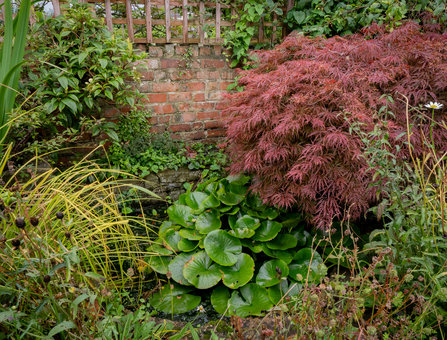
Stephanie Chadwick
Advice from the Team Wilder Community Ecologist
Potted mini meadows You have already got wildflowers present along the borders of the beds which look amazing and are really beneficial to wildlife! You could even add additional pots to the patio which can be sown with a wildflower mixture to really benefit pollinators even more! Find wildflowers that are suited for shaded and sunny locations - see Grow Wilder, Habitat Aid, Emorsgate Seed or Naturescapes for seed mixes.
Bird boxes A number of different birds use your feeder such as starlings and sparrows. If possible, you could install a sparrow terrace on your fence or house (make sure that it is the eastern or northern elevations). Sparrows are a colonial species and so live in groups. Therefore, a sparrow terrace with three holes is recommended as this allows the sparrows to live close together. NHBS and Wildcare offer sparrow terraces.
Vertical spaces Climbing plants can be added to the vertical space, such as walls and fences, to enhance the value for wildlife. Species such as ivy, honey suckle, climbing rise, hops, passion flower and jasmine could be grown. Honey suckle is a night-scented plant and would also attract moths, which would then benefit bats.
How to create vertical spaces
Mini pond You have one larger pond in the garden which is great and I recommend that you have a small mini pond (which can be on the patio) too just to add another stepping stone for wildlife.
Mini ponds
Hedgehog highways You have installed one hedgehog highway on the back fence of the garden which is good to see! If you can, you could see if your neighbors want to create hedgehog highways between the gardens so that you join up the back gardens along the street.
Hedgehog highway
Resources

West of England Combined Authority and Natural History Consortium
Be part of Team Wilder
Feeling inspired by this wildlife garden? Try something for yourself at home, in your community, school, business or land, no matter the size.
All actions for nature collectively add up and makes a difference for people and wildlife.
Share your actions for nature, like Jenny, and motivate others to do the same.
Log your actions for nature on the map











